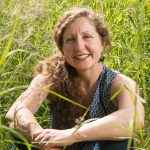It’s time to get it right with Tongass, timber, carbon and climate change
By Catherine M. Mater and Dominick A. DellaSala
Opinion article published August 29, 2019 in the Juneau Empire
A perfect storm is brewing in Southeast Alaska and all weather vanes are pointing to the Tongass National Forest — the “Amazon” of America that serves as lungs of the nation by absorbing and storing the equivalent of almost 10 percent of all the carbon retained in U.S. forests. Alaska has been in the national news with coverage of dried-up salmon spawning grounds due to unprecedented drought, and dwindling deer populations from logging old growth on Prince of Wales Island; all while the White House and Alaskan officials double down on eliminating protections for Alaska’s roadless old growth stands.
Understanding the connection between the Tongass, continued timber production, climate change and the real need for creating economic development in the state has never been more urgent. But these seemingly disparate silos offer a comprehensive solution.
While the state’s forest products industry that relies on old growth timber has sharply declined, a new one is emerging focused on transitioning out of old growth logging to reliance on Tongass young growth — 55-75-year-old trees — timber supply.
Between 2016-2018, resulting from Congressional funds secured by Sen. Lisa Murkowski, the Forest Service completed the most intensive young forest inventory ever conducted on the Tongass previously logged by the pulp and paper industry 50 years ago. Approximately 140,000 acres of these clustered, low elevation young growth acres are outside all environmentally sensitive areas and are within 800 feet of currently open forest service roads, so little road building would be required. The Forest Service inventoried over 40,000 of these acres within the Prince of Wales, Ketchikan, Petersburg and Kake supply circles. Supplemental work conducted by Juneau-based Geos Institute and the Alaska office of the Natural Resource Defense Council and shared with the Forest Service underscore an undeniable “wall of wood” opportunity to begin transitioning the Alaska timber industry based on sustainable forest management principles not evidenced in prior old growth logging, all the while preserving currently protected old growth acres for climate, subsistence and recreation benefits. Importantly, many of these abundant low-risk, accessible young growth stands, according to Forest Service inventory results, are already producing merchantable timber in per acre volumes often equal to that produced from old growth stands and have age class distributions that can support a sustainably managed forest products industry for decades to come.
The young growth stands are taller and have larger diameters than expected — meeting Tongass Advisory Council requirements for transition — and generate less than 2 perfect defect after harvest compared to 70 percent defect from old growth stands. The recent 2019 Kuiu old growth timber sale offers hard-learned lessons on why a transition to young growth needs to rapidly happen. With over 10 miles of road construction required to reach Kuiu timber supply and 70 percent defect, the project simply didn’t pencil out, and no bids were received.
Existing regional mills would need to install small log processing technology to efficiently process the new young growth supply, but capitalization for these renovations would be highly supported by the public and of keen interest to private funding sectors. And after 3 years of peer-reviewed project design development and field work undertaken by the Forest Service Research Station on Tongass young growth, the next step is to establish a Young Growth Wood Quality Pilot manufacturing line that would process young timber to test for lumber grade recovery and market demand for manufactured products
Tongass and Sealaska Timber Corporation young growth logs have been sold to export markets for almost a decade.
Taking a page from Sealaska’s playbook, the 9 million acres of old growth targeted for logging in the Alaska Roadless Rule could be set aside for permanent protection and accumulating atmospheric carbon stores. Payments for those forest carbon stores could come from heavy carbon emitters such as the cruise ships that now enter and launch from Alaskan shores. Recent 2019 investigative reports show that each of these ships emits as much particulate matter to the atmosphere as one million cars every day.
For Alaska a clear choice exists on the Tongass: navigate a new course with an abundant young growth “wall of wood” or continue the old growth course towards conflict and litigation. That perfect storm is now.
Catherine M. Mater is President of Oregon-based Mater Ltd, an 80-yr old forest products engineering and market research firm servicing world-wide clients. She is the lead investigator and author on the Tongass Young Growth Transition Project.
Dominick A. DellaSala is an award-winning scientist at the Geos Institute (Ashland, Juneau) with over 200 publications, including “Temperate and Boreal Rainforests of the World: Ecology and Conservation.”
Join the Cornerstone Network
Sign up with a monthly donation and become part of our Cornerstone Network. Network members recieve the messages posted here first, delivered directly to your inbox. Your ongoing support is the foundation of our work.

 Samantha Medlock is President of Climate Risk Advisors, helping communities and organizations advance equity, sustainability, and resilience. Her career began chasing floods as a local official in Texas Flash Flood Alley—a hands-on experience that still shapes her approach to climate and disaster risk management.
Samantha Medlock is President of Climate Risk Advisors, helping communities and organizations advance equity, sustainability, and resilience. Her career began chasing floods as a local official in Texas Flash Flood Alley—a hands-on experience that still shapes her approach to climate and disaster risk management.
 Arsum is the Senior Adaptation and Coastal Resilience Specialist for the National Wildlife Federation’s Southcentral Region. In this role, she advances climate adaptation efforts, with a focus on nature-based approaches to address the impacts of climate change and extreme events across the Gulf region. She has authored and co-authored numerous publications on climate impact assessments and adaptation solutions. Additionally, she regularly participates in state-based coastal resilience and hazard mitigation planning across the Gulf, collaborating with regional and local stakeholders.
Arsum is the Senior Adaptation and Coastal Resilience Specialist for the National Wildlife Federation’s Southcentral Region. In this role, she advances climate adaptation efforts, with a focus on nature-based approaches to address the impacts of climate change and extreme events across the Gulf region. She has authored and co-authored numerous publications on climate impact assessments and adaptation solutions. Additionally, she regularly participates in state-based coastal resilience and hazard mitigation planning across the Gulf, collaborating with regional and local stakeholders. Frank is the former President of the Reinsurance Association of America. Frank currently serves on the Advisory Board of the OECD’s International Network for the Financial Management of Large-Scale Disasters, the RAND Center on Catastrophic Risk Management and Compensation, and the University of Cincinnati’s Carl H. Lindner III Center for Insurance and Risk Management Advisory Board.
Frank is the former President of the Reinsurance Association of America. Frank currently serves on the Advisory Board of the OECD’s International Network for the Financial Management of Large-Scale Disasters, the RAND Center on Catastrophic Risk Management and Compensation, and the University of Cincinnati’s Carl H. Lindner III Center for Insurance and Risk Management Advisory Board. Jim is a multilingual world traveler. Based in Bavaria during the 1970s, Jim spent most of this period in India, Afghanistan and Nepal, where he founded and operated a charitable medical clinic serving Tibetan Refugees. He settled in Oregon in 1983 on a forested ranch in the Umpqua National Forest.
Jim is a multilingual world traveler. Based in Bavaria during the 1970s, Jim spent most of this period in India, Afghanistan and Nepal, where he founded and operated a charitable medical clinic serving Tibetan Refugees. He settled in Oregon in 1983 on a forested ranch in the Umpqua National Forest. Dr. Micah Hahn is an Associate Professor of Environmental Health in the Institute for Circumpolar Health Studies at the University of Alaska-Anchorage. She received her joint PhD in Epidemiology / Environment and Resources from the University of Wisconsin-Madison and her MPH in Global Environmental Health from Emory University. Subsequently, she was a postdoctoral fellow for the CDC Climate and Health Program, and in this position worked collaboratively with the CDC Division of Vector-borne Diseases and the National Center for Atmospheric Research. Her research focuses on understanding the health impacts of climate change and working with communities to develop locally-relevant adaptation and resilience-building strategies. Dr. Hahn is also on the Management Team of the Alaska Climate Adaptation Science Center.
Dr. Micah Hahn is an Associate Professor of Environmental Health in the Institute for Circumpolar Health Studies at the University of Alaska-Anchorage. She received her joint PhD in Epidemiology / Environment and Resources from the University of Wisconsin-Madison and her MPH in Global Environmental Health from Emory University. Subsequently, she was a postdoctoral fellow for the CDC Climate and Health Program, and in this position worked collaboratively with the CDC Division of Vector-borne Diseases and the National Center for Atmospheric Research. Her research focuses on understanding the health impacts of climate change and working with communities to develop locally-relevant adaptation and resilience-building strategies. Dr. Hahn is also on the Management Team of the Alaska Climate Adaptation Science Center. Michael is a former Founding Principal of Resilient Cities Catalyst, a global non-profit helping cities and their partners tackle their toughest challenges. He is currently the Executive Director of Climate Resilience Academy at the University of Miami.
Michael is a former Founding Principal of Resilient Cities Catalyst, a global non-profit helping cities and their partners tackle their toughest challenges. He is currently the Executive Director of Climate Resilience Academy at the University of Miami. Dr. Quintus Jett is a consultant, educator, and strategist for public causes. He has a doctorate in Organizations & Management from Stanford University, and a two-decade faculty career which spans schools, departments, and programs of business, engineering, liberal studies, divinity, and public and nonprofit management. Following Hurricane Katrina in 2005, Dr. Jett launched a volunteer project in New Orleans, which enlisted residents, students from over a dozen colleges and universities, and hundreds of others to field map the city’s Gentilly district, Lower Ninth Ward, and New Orleans East. Dr. Jett is an innovator in higher education, bridging the divide between academic research and the other priorities of the modern university, including student access and diversity, community engagement, and providing foundations for life-long learning in today’s rapidly changing world.
Dr. Quintus Jett is a consultant, educator, and strategist for public causes. He has a doctorate in Organizations & Management from Stanford University, and a two-decade faculty career which spans schools, departments, and programs of business, engineering, liberal studies, divinity, and public and nonprofit management. Following Hurricane Katrina in 2005, Dr. Jett launched a volunteer project in New Orleans, which enlisted residents, students from over a dozen colleges and universities, and hundreds of others to field map the city’s Gentilly district, Lower Ninth Ward, and New Orleans East. Dr. Jett is an innovator in higher education, bridging the divide between academic research and the other priorities of the modern university, including student access and diversity, community engagement, and providing foundations for life-long learning in today’s rapidly changing world. Scott is Monfort Professor of Atmospheric Science at Colorado State University. He has written about 100 publications in the peer-reviewed climate literature, is a former editor of the Journal of Climate, and served for five years as founding Science Chair of the North American Carbon Program.
Scott is Monfort Professor of Atmospheric Science at Colorado State University. He has written about 100 publications in the peer-reviewed climate literature, is a former editor of the Journal of Climate, and served for five years as founding Science Chair of the North American Carbon Program. Linda has many years of experience in disaster preparedness and resilience. She has been an elected official on the Linn County Iowa Board of Supervisors, Chair of the Metropolitan Planning Organization, the East Central Iowa Council of Governments, the statewide Mental Health Developmental Disability and the Linn County Board of Health. Langston is a former president of the National Association of Counties (2013-2014).
Linda has many years of experience in disaster preparedness and resilience. She has been an elected official on the Linn County Iowa Board of Supervisors, Chair of the Metropolitan Planning Organization, the East Central Iowa Council of Governments, the statewide Mental Health Developmental Disability and the Linn County Board of Health. Langston is a former president of the National Association of Counties (2013-2014). Ken works with families and organizations as a mediator, organizational consultant, trainer and facilitator. Along with his passion for helping people prepare for and reduce climate change, Ken also volunteers as a mediator through Mediation Works and is passionate about supporting youth through mentoring with Boys to Men of Southern Oregon.
Ken works with families and organizations as a mediator, organizational consultant, trainer and facilitator. Along with his passion for helping people prepare for and reduce climate change, Ken also volunteers as a mediator through Mediation Works and is passionate about supporting youth through mentoring with Boys to Men of Southern Oregon. Matthew is a retired high school teacher who was once honored as Oregon High School Social Studies Teacher of the Year. Before his teaching career he was in the restaurant business in Portland. He is also a lawyer who has been a member of the Oregon State Bar Association since 1980.
Matthew is a retired high school teacher who was once honored as Oregon High School Social Studies Teacher of the Year. Before his teaching career he was in the restaurant business in Portland. He is also a lawyer who has been a member of the Oregon State Bar Association since 1980. Andrea is the Resilience Policy Advisor for the North Carolina Office of Recovery and Resiliency. She works across state agencies and with local governments to increase the state’s resilience to the impacts of climate change.
Andrea is the Resilience Policy Advisor for the North Carolina Office of Recovery and Resiliency. She works across state agencies and with local governments to increase the state’s resilience to the impacts of climate change.